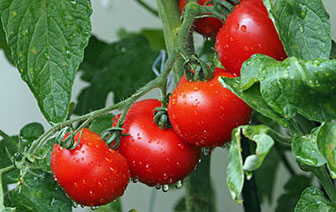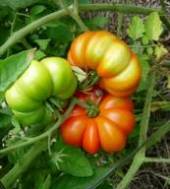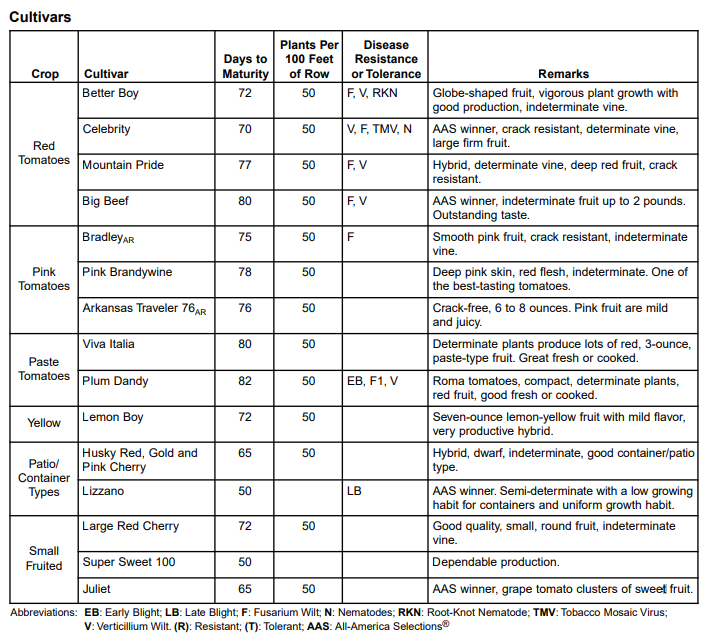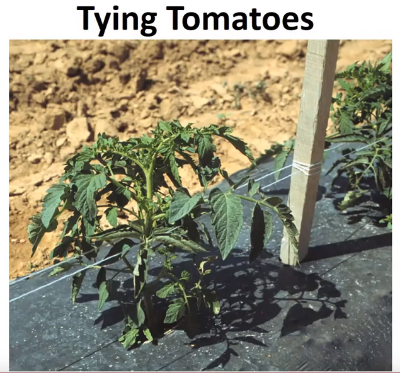Growing Tomatoes in Arkansas
 Do you grow tomatoes? We have research-based information about planting tomatoes and
disease management. Check out the videos, tips, and fact sheets below.
Do you grow tomatoes? We have research-based information about planting tomatoes and
disease management. Check out the videos, tips, and fact sheets below.
What's wrong with your tomatoes?
Use our Tomato Diagnosis App to troubleshoot your plants
How do I get started with growing tomatoes?
If you're just getting started with tomatoes watch this quick overview video.
Download the tomato fact sheet
For more detailed information watch our in-depth webinar!
Tomato Gardening Webinar
What are the best growing conditions for tomatoes?
- Light – sunny. 6-8 hours of sun MINIMUM. Avoid planting near trees.
- Soil – well-drained loam. Avoid wet feet on the plant.
- Fertility and pH - pH – 5.8 to 7.2. Lime if needed. Test your soil before you plant.
- Temperature – warm. Ideal temperatures are 80s during the day and 50s or 60s at night. If you're comfortable, the tomatoes will be comfortable. If it's too hot, tomatoes have trouble setting fruit.
- Moisture – moist. Water the plants thoroughly every two to four days during dry periods. Plants in containers need daily watering.
- Irrigation - apply water so leaves will be dry going into the evening. Soaker hoses work well but some will have a sprinkler effect. Drip tape can be used for slower application to conserve water.
Culture
- Planting – transplant after danger of frost or midsummer. Late plantings may be made in early July for fall harvest and storage. These plants have the advantage of increased vigor and freedom from early diseases.
- Spacing – 18-24 x 48-72 inches
- Hardiness – tender, frost sensitive
- Fertilizer – heavy feeder
Which tomatoes grow best in Arkansas?

Choose the cultivars best suited for your intended use and method of culture. Small-fruited cultivars, such as cherry tomatoes, set fruit during periods of high temperature that limit fruit production of the large-fruited types.
Our webinar gives detailed lists of pink, red, cherry, and slicer tomato options.
The tomato cultivar list below can be found in our tomato fact sheet.
Staking and tying tomatoes
You can train tomato plants to stakes, trellises or cages to improve air circulation and eliminate contact with the soil. This allows more sunlight into the canopy and allow for better spray coverage. It's also easier to control pests and pick the fruit. Wire cages placed over small tomato plants hold the vines and fruit off the ground. Short cages (3 feet high) usually support themselves when the wire prongs at the bottom are pushed into the ground.
Taller cages require a stake, post or wire for support. Large mesh (6 x 6 inch) wire permits easy harvesting. Tomato plants must be tied to supporting stakes or to a trellis because they do not support themselves with tendrils, unlike cucumber plants. Loop ordinary soft twine, cord or cloth loosely around the main stem and tie it tightly to the stake.
Watch the video to learn more about staking and tying tomatoes.
Grafting Tomatoes
Harvesting tomatoes
- Tomatoes reach full size in 20 to 30 days, about half the length of the total ripening period.
- Tomatoes should be harvested when they are firm and changing color.
- They are of highest quality when they ripen on healthy vines and daily temperatures are about 80 degrees F. When temperatures are higher (90 degrees F or more), the softening process is accelerated and color development is retarded.
- During hot summer weather, pick tomatoes every day or every other day.
- Harvest the fruit when it has a healthy pink color and ripen it further indoors (at 70 to 75 degrees F).
- Harvest all green, mature fruit in the fall on the day before a killing frost is expected. Wrap the tomatoes individually in paper and store at 55 to 65 degrees F. They will ripen slowly during the next several weeks.
Looking for storage tips or recipes for your harvest?
Check out our page Tomatoes - Storing & Preparing Harvest
Tomato gardening FAQ
Leaf roll (when the leaves curl) is a physiological condition that occurs most commonly when plants are trained and pruned. Any type of stress can cause leaf roll. It does not affect fruiting or quality and it is not a disease.
During unfavorable weather (night temperatures lower then 55 degrees or about 72 degrees and day temperatures about 95 degrees with dry, hot winds), tomatoes do not set fruit and the flowers drop. The problem usually disappears as the weather improves.
Your tomato plants have been injured by 2,4-D or a similar weed killer. Never use the same sprayer for weed control on your vegetable garden you used on your lawn. Drift from herbicides originating one-half mile or more away can also injure tomato plants. A virus disease called "cucumber mosaic virus" (CMV) can mimic these symptoms.
Fertilize the garden before planting tomatoes. Apply fertilizer again when fruit first sets. After the first fruit sets, side-dress the plants with additional fertilizer every two weeks. Fertilizer plants grown on sandy soils more frequently than those grown on heavy clay soils. A general side-dress fertilizer recommendation is 1.5 tablespoons of a complete fertilizer (10-20-10 or 13-13-13) scattered around the plant and worked into the soil.
Blossom-end rot is caused by improper moisture conditions. This results in a calcium deficiency in the developing fruit. Make sure the soil pH is above 6.0/ Maintain uniform soil moisture as the fruit grows. Remove affected fruit. When possible, use calcium nitrate to fertilize the plants.
Never refrigerate tomatoes if immature when picked. Place them ina single layer ar room temperature, and allow them to develop full color. When fully ripe, place them in the refrigerator where they can be stored for several weeks.
This is southern blight, a soilborne fungus that lives in organic material in the soil. Deep burial of under-composted organic material in the soil reduces this problem. Control foliage diseases of tomato plants, because the fallen leaves around the base of the plant feed the fungus and allow it to build up near the plant and cause damage. Crop rotation also reduces the incidence of southern blight.
This is fusarium wilt caused by a soilborne fungus that attacks tomatoes and other crops. Use resistant varieties to control this disease. Most commercial tomato varieties are resistant. Before you plant a cultivar, make sure it is resistant to fusarium wilt. This resistance to denoted by the letter F after the name; for example, Celebrity VFN.
This is Alternaria leaf spot or early blight, a common problem on tomatoes that causes defoliation usually during periods of high rainfall. Plant tomatoes on a raised bed to remove water drainage, and space them so air can move to dry the foliage and prevent diseases. Start a fungicide spray program when the fruit is set and continue at one-week intervals during the growing season until harvest. Use a fungicide such as Daconil approved from home garden use.
Several types of leaf spots attack tomatoes. Septoria leaf spot quite often starts at the bottom of the plant and rapidly spreads. It can be controlled with a fungicide spray. Begin the spray program early in the life the plant.
Many conditions may cause these symptoms, including spider mites, diseases and nutrient deficiencies. Examine the underside of the leaves for small, red to greenish mites. If you find mites, treat with two to three applications of insecticides at five day intervals.
Yes. Fruits harvested at the first blush of pink will ripen fully. A tomato picked at the first sign of color and ripened at room temperature will be just as tasty and colorful as one left to fully mature on the vine. Picking tomatoes before they turn red reduces bird and squirrel damage.
Several conditions can cause tomatoes not to set fruit. Too much nitrogen fertilizer, nighttime temperatures over 75 degrees, low temperatures below 50 degrees, irregular watering, insects, or planting the wrong cultivar may result in poor fruit sets.
Some varieties are less acidic than others. Some yellow-fruited types are slightly less acidic than the normal red varieties. Flavor differences between varieties are not because of differences in acid content but the sugar-to-acid balance. Cherry tomatoes are higher in both sugar and avid levels.
The diameter of the cage should be at least 18 to 20 inches at the top. Smaller cages often restrict plant growth and reduce yields. Hight of the cage varies, but generally 3.5 feet is recommended.
Cracking is a physiological disorder caused by soil moisture fluctuations. When the tomato reaches the mature green stage, reduce or cut off the water supply to the plant as the tomato begins to reopen. At this time, the skin around the outer surface of the tomato becomes thicker and more rigid to protect the tomato during the harvest. if the water supply is restored after ripening begins, the plant resumes translocation of nutrients and moisture into the fruit. This causes the fruit to enlarge, and the skin splits around the fruit resulting in cracking. The best control for cracking is a constant and regular water supply. Apply a layer of organic mulch to the base of the plant. This serves as a buffer and prevents soil moisture fluctuations. Some varieties are resistant to cracking, and we recommend these varieties.
These are root-knot nematodes. Some varieties such as Celebrity and better boy resist this problem. It is best to use only nematode-resistant varieties. Nematode resistance is shown by the letter N after the name. For example, Celebrity VFN.
Your fruit has been invaded by tomato pinworms. They usually do not damage the fruit and can be controlled only by a preventative insecticide spray ever 7 - 10 days. When the damage is evident, it is too late to do anything about it.
Got tomato problems?
Serious tomato diseases in Arkansas are caused by viruses, bacteria, fungi and nematodes. Our detailed fact sheet gives tomato growers information on managing all four threats to healthy tomato production.
Check out our Plant Pathology Pal to browse our tomato disease images and diagnose your plant.
You can also check out these resources:
Managing tomato diseases in Arkansas
FAQs on tomato production - advice from former Master Gardener leader Janet Carson.
Learn More about Tomato Gardening
- Tomato Gardening Fact Sheet
- Search the Plant Disease Image Library
- Tomato Diseases and Disorders
- Around the Homestead Podcast

